Flowering dogwoods can be harmed by various pests and diseases. Opt for disease-resistant dogwood varieties or explore alternative ornamental options with similar beauty but less susceptibility to pests.
Cornus, commonly known as dogwood, is a genus of around 60 species, primarily of shrubs and small trees, with the flowering dogwood (Cornus florida) being one of the most renowned.
Native to the Eastern United States, these unique small trees thrive in Zones 5-9 and are celebrated for their beautiful blossoms in the spring, full canopy in the summer, red berries, and vibrant foliage in the fall.
However, flowering dogwoods are threatened by various pests and diseases that can adversely affect their health and longevity.
Dogwood anthracnose is a fungal disease caused by the fungus Discula destructive. It is particularly devastating because it can lead to the premature death of the tree. The disease was first identified in the United States in the late 1970s, initially in the northeastern states and then spreading to the Appalachian region. Over the years, it has become a significant concern in both natural forests and ornamental landscapes.
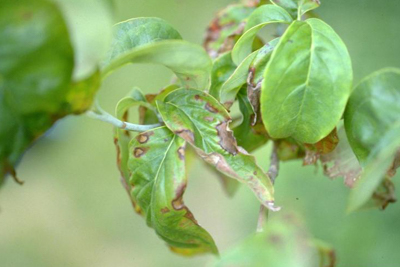 Dogwood Anthracnose Dogwood Anthracnose |
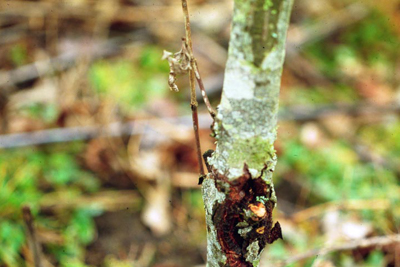 Dogwood Anthracnose Canker Dogwood Anthracnose Canker |
Early detection and proactive management are key to controlling the spread of dogwood anthracnose.
Powdery mildew is a common fungal disease that affects a wide range of plants, including dogwoods, vegetables, and ornamental plants.
While not usually fatal, this fungal disease can threaten the tree’s beauty, undermine its strength, impede growth, and reduce flower production. Repeated infections can seriously damage trees and make them susceptible to other pests and problems.
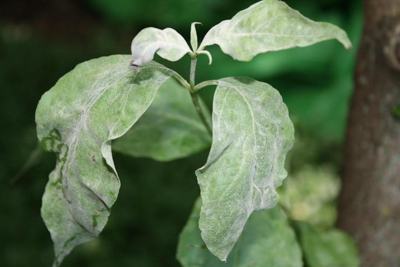 Powdery mildew on dogwood leaves and shoot. Powdery mildew on dogwood leaves and shoot. |
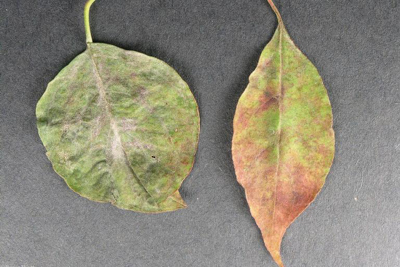 Powder Mildew Mycelium on leaf surface Powder Mildew Mycelium on leaf surface |
Spot anthracnose is a fungal disease caused by the fungus Elsinoë corni. It is often confused with dogwood anthracnose, although it is generally less severe. Spot anthracnose primarily affects the aesthetic value of the tree rather than its overall health.
Repeated infections can weaken trees and cause sparse flowers and foliage.
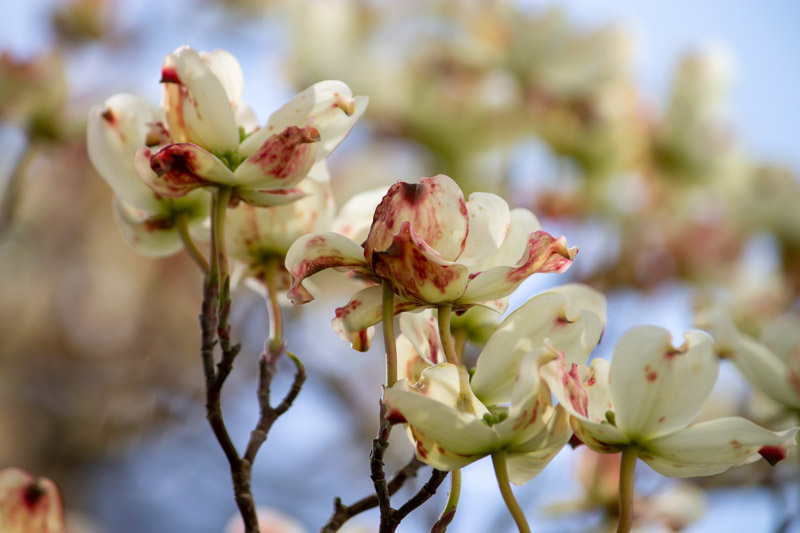 Spot Anthracnose on Dogwood Bracts
Spot Anthracnose on Dogwood Bracts
Planting a disease-resistant dogwood tree is an excellent proactive measure to ensure the long-term health and beauty of your landscape. Disease-resistant varieties are less susceptible to common problems like powdery mildew, spot anthracnose, and dogwood anthracnose.
| Plant Name | Dogwood Anthracnose Resistance | Powdery Mildew Resistance | Spot Anthracnose Resistance |
| Cornus florida Appalachian Spring | Yes | ||
| Cornus florida Appalachian Joy | Yes | ||
| Cornus florida Cherokee Brave | Yes | Yes | |
| Cornus florida Cherokee Chief | Yes | Yes | |
| Cornus florida Cherokee Princess | Yes | ||
| Cornus florida Dwarf Pink | Yes | ||
| Cornus florida Emerald Star | Yes | ||
| Cornus florida First Lady | Yes | ||
| Cornus florida Fragrant Cloud | Yes | ||
| Cornus florida Gold Star | Yes | ||
| Cornus florida Jean’s Appalachian Snow | Yes | ||
| Cornus florida Karen’s Appalachian Blush | Yes | ||
| Cornus florida Kay’s Appalachian Mist | Yes | ||
| Cornus florida Plena | Yes | ||
| Cornus florida Purple Glory | Yes | ||
| Cornus florida Springtime | Yes | ||
| Cornus florida Weaver’s White | Yes | Yes | |
| Cornus florida Welch’s Bay Beauty | Yes | Yes | |
| Cornus kousa | Yes | ||
| Cornus kousa Agate | Yes | ||
| Cornus kousa Angustata | Yes | ||
| Cornus kousa Autumn Rose | Yes | ||
| Cornus kousa Beni Fuji | Yes | ||
| Cornus kousa Big Apple | Yes | ||
| Cornus kousa Blue Shadow | Yes | ||
| Cornus kousa Bodent Form | Yes | ||
| Cornus kousa Bush’s Pink | Yes | ||
| Cornus kousa China Girl | Yes | ||
| Cornus kousa Doubloon | Yes | ||
| Cornus kousa Elizabeth Lustgarten | Yes | Yes | |
| Cornus kousa Empire | Yes | Yes | |
| Cornus kousa Gay Head | Yes | ||
| Cornus kousa Greensleeves | Yes | ||
| Cornus kousa Japanese Cornel | Yes | ||
| Cornus kousa Julian | Yes | ||
| Cornus kousa Lustgarten Weeping | Yes | ||
| Cornus kousa Milky Way | Yes | Yes | Yes |
| Cornus kousa Milky Way Select | Yes | Yes | |
| Cornus kousa Moonbeam | Yes | ||
| Cornus kousa National | Yes | Yes | |
| Cornus kousa Pam’s Mountain Bouquet | Yes | Yes | |
| Cornus kousa Porlock | Yes | ||
| Cornus kousa Red Steeple | Yes | Yes | |
| Cornus kousa Satomi | Yes | Yes | |
| Cornus kousa Scarlet Fire (‘Rutpink’) | Yes | Yes | |
| Cornus kousa Steeple | Yes | ||
| Cornus kousa Snow Flake | Yes | ||
| Cornus kousa Spring Grove | Yes | ||
| Cornus kousa Square Dance | Yes | ||
| Cornus kousa Temple Jewel | Yes | ||
| Cornus kousa Trinity Star | Yes | ||
| Cornus kousa Willamette | Yes | ||
| Cornus kousa Wolf Eyes | Yes | ||
| Cornus kousa var. chinensis | Yes | ||
| Cornus x rutgersensis ‘Rutban’ Aurora | Yes | Yes | Yes |
| Cornus x rutgersensis ‘Rutdan’ Celestial | Yes | Yes | Yes |
| Cornus x rutgersensis ‘Rutcan’ Constellation | Yes | Yes | Yes |
| Cornus x rutgersensis ‘Rutlan’ Ruth Ellen | Yes | Yes | Yes |
| Cornus x rutgersensis ‘Rutfan’ Stardust | Yes | Yes | |
| Cornus x rutgersensis ‘Rutgan’ Stellar Pink | Yes | Yes | Yes |
| Cornus alba | Yes | ||
| Cornus alba Bud’s Yellow | Yes | ||
| Cornus alternifolia | Yes | ||
| Cornus canadensis | Yes | ||
| Cornus controversa | Yes | Yes | |
| Cornus mas | Yes | Yes | |
| Cornus sericea | Yes | ||
| Cornus x ‘KN4-43’ Starlight | Yes | ||
| Cornus x ‘KN30-8’ Venus | Yes |
If you’re looking for alternative shrubs and trees to the flowering dogwood, there are many options to consider. These alternatives can provide similar aesthetic appeal, and many are resistant to the diseases that commonly plague dogwoods. Here are some alternatives:
| Hardiness |
5 - 9 |
|---|---|
| Plant Type | Shrubs, Trees |
| Genus | Cornus |
| Exposure | Full Sun, Partial Sun |
| Season of Interest |
Spring (Early, Mid, Late) Summer (Early, Mid, Late) Fall Winter |
| Maintenance | Low |
| Water Needs | Average |
| Soil Type | Chalk, Clay, Sand |
| Soil pH | Acid, Neutral |
| Soil Drainage | Moist but Well-Drained, Well-Drained |
| Characteristics | Showy |
| Native Plants | United States, Maine, Massachusetts, Maryland, New Hampshire, New Jersey, Delaware, Pennsylvania, Rhode Island, Vermont, Connecticut, New York, Southeast, Midwest, Northeast, Southwest, Kansas, Indiana, Ohio, Minnesota, Missouri, Illinois, Florida, West Virginia, Alabama, Arkansas, Kentucky, Georgia, Louisiana, North Carolina, Mississippi, South Carolina, Tennessee, Virginia, Oklahoma, Texas |
| Attracts | Bees, Birds, Butterflies |
| Landscaping Ideas | Beds And Borders |
| Garden Styles | City and Courtyard, Informal and Cottage |
| Hardiness |
5 - 9 |
|---|---|
| Plant Type | Shrubs, Trees |
| Genus | Cornus |
| Exposure | Full Sun, Partial Sun |
| Season of Interest |
Spring (Early, Mid, Late) Summer (Early, Mid, Late) Fall Winter |
| Maintenance | Low |
| Water Needs | Average |
| Soil Type | Chalk, Clay, Sand |
| Soil pH | Acid, Neutral |
| Soil Drainage | Moist but Well-Drained, Well-Drained |
| Characteristics | Showy |
| Native Plants | United States, Maine, Massachusetts, Maryland, New Hampshire, New Jersey, Delaware, Pennsylvania, Rhode Island, Vermont, Connecticut, New York, Southeast, Midwest, Northeast, Southwest, Kansas, Indiana, Ohio, Minnesota, Missouri, Illinois, Florida, West Virginia, Alabama, Arkansas, Kentucky, Georgia, Louisiana, North Carolina, Mississippi, South Carolina, Tennessee, Virginia, Oklahoma, Texas |
| Attracts | Bees, Birds, Butterflies |
| Landscaping Ideas | Beds And Borders |
| Garden Styles | City and Courtyard, Informal and Cottage |
Create a membership account to save your garden designs and to view them on any device.
Becoming a contributing member of Gardenia is easy and can be done in just a few minutes. If you provide us with your name, email address and the payment of a modest $25 annual membership fee, you will become a full member, enabling you to design and save up to 25 of your garden design ideas.
Join now and start creating your dream garden!
Create a membership account to save your garden designs and to view them on any device.
Becoming a contributing member of Gardenia is easy and can be done in just a few minutes. If you provide us with your name, email address and the payment of a modest $25 annual membership fee, you will become a full member, enabling you to design and save up to 25 of your garden design ideas.
Join now and start creating your dream garden!